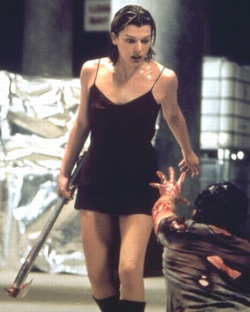We are developing the social individualist meta-context for the future. From the very serious to the extremely frivolous... lets see what is on the mind of the Samizdata people.
Samizdata, derived from Samizdat /n. - a system of clandestine publication of banned literature in the USSR [Russ.,= self-publishing house]
|
Not me, that is for sure. Even harder to figure out is the film going public… and after a chat with Hollywood film producer and blogger Brian Linse the other day, I get the impression from him that even Hollywood cannot figure out the film going public.
Take two movies, both based on computer games. Firstly, Tomb Raider, staring Angelina Jolie as Lara Croft.

Angelina Jolie as Lara Croft: striking a Lara-ish stance
The Tomb Raider series of computer games were massive and more or less redefined the genre. I thought they were all quite gripping and am very eager to get my paws on the latest episode of Lara Croft’s adventures, Tomb Raider: Angel of Darkness.

Angel of Darkness: Lara Croft in all her pixellated glory!
As you might expect, I was rather keen to see Tomb Raider: The Movie, directed by Simon West. It had everything going for it: Angelina Jolie is an interesting looking woman and without doubt a technically skilled actress. Although she is not quite ready to challenge Gwyneth Paltrow for her crown as ‘Best-Yank-Actress-who-can-do-a-perfect-British-accent’, she is pretty damn good nonetheless.
The film clearly had a truly humongous budget, was adequately acted and tolerably directed in parts (with a couple startlingly bad scenes: it takes a certain perverse skill for a director to make a gratuitous shower scene with Angelina Jolie laughable for all the wrong reasons). Unfortunately the story line was weak, convoluted and confusing. Worst of all, the production was dire: it was almost as if it was three separate movies, casually spliced together, differently paced as if styled by three sets of completely unconnected film makers, then finally so badly edited as to make some parts of the story incomprehensible. Although Tomb Raider: The Movie was not utterly without merits, the overall effect was shockingly disappointing.  
And yet, due to the Tomb Raider/Lara Croft brand name and massive marketing, this clunker rode out the appropriately scathing reviews and was by no means a commercial failure in spite of costing a great deal to make. A sequel is in the pipeline.
And then let us look as the second movie, Resident Evil staring Milla Jovovich as Alice.

Milla Jovovich as Alice: about to demonstrate how unhappy she is with her ex-boyfriend
The game that the movie is based on, similarly called Resident Evil is a big name in the Playstation console world, but it does not have anything like the brand recognition of ‘Tomb Raider’ and ‘Lara Croft’ with the general public.

Killer pixels: Veronica from the Resident Evil – Code V game
The Resident Evil movie, directed by Paul Anderson, clearly has a far smaller budget, it was marketed poorly to put it mildly and with the exception of Milla Jovovich (Fifth Element, Zoolander, Blue Lagoon, Two Moon Junction etc.) had a cast of more or less unknowns. Resident Evil had a simple but nearly flawlessly executed story, was artfully directed, skillfully produced and very atmospheric. It was well cast and Milla was excellent as the killer amnesiac conspirator known simply as ‘Alice’… and unlike the jarring T&A scene in Tomb Raider, the opening shower sequence with dazed Milla worked perfectly, setting the deliciously ill-at-ease tone for the whole movie.
In short, this movie rocks… vastly superior to ‘Tomb Raider: The Movie’ on every level. It has no pretensions to be high art or intellectually challenging, but it does exactly what it sets out to do with considerable flair.  
And yet unlike the dismal Tomb Raider, Resident Evil almost immediately vanished off the screens and onto video/DVD. Fortunately, because it cost so little to make, the picture seems to have still made a profit and thus in this case too, a sequel is in the pipeline called Resident Evil: Nemesis (which will no doubt cause confusion with the impending Star Trek movie called ‘Nemesis’). Movie making is a very strange business.
Go out and buy or rent Resident Evil: The Movie on DVD or Video, it is destined to be a cult classic. Avoid Tomb Raider: The Movie like it was smallpox.
Update: The Resident Evil follow-up movie has been retitled Resident Evil: Apocalypse, presumably to avoid confusion with the recent Start Trek movie flop called ‘Nemesis’
Well, this Samizdatista finally donned his false beard and shades to spy on the latest James Bond epic, Die Another Day at the weekend. After stumbling out of the cinema, my ears still ringing after nearly two hours of loud bangs and eye-scortching special effects, here are my random thoughts about it.
My first thought about the film is that the franchise has become so entrenched as a formula that they resemble cartoons more than films with real people. I like Pierce Brosnan, who plays Bond with a certain wry wit and swagger (though he ain’t a patch on Sean Connery), but overall the film just doesn’t have that certain X-factor, that sense of style and sophistication, which made the early films so much fun. I miss the John Barry scores, which created a haunting background tone of their own. There is virtually no connection any more between the Bond of the cinema and the complex character that Ian Fleming created all those years ago in the Cold War.
I quite liked the opening sequence, even the bit where our Jim gets roughed up in the North Korean prison (glad to see one of the Axis of Evil nations getting ragged in the movies. George W. Bush will love it). You don’t get much of this in most Bond films, where the hero seems to pass through all manner of combats with nary a hair out of place. For once 007 gets a hard time. I sensed some members of the audience got a bit uncomfortable about that. But I thought it gave the film a bit of an edge we haven’t seen before, and the film-makers deserve some credit for that.
But the basic plot idea, of an errant North Korean bad boy plotting world domination via a scheme to harness diamond tech. to vaporise the West, was, well, so damn implausible that it lost me. In fact, quite a lot of the film was pretty much like outright science fiction. Now don’t get me wrong – I like science fiction. But the key to the best Bond films was ability to keep just this side of plausibility. The trouble with this one is that it falls right off the edge. Admittedly the makers may believe they have to create a diabolical villain while skating over the hottest current world controversies so as not to offend unduly. I cannot quite imagine 007 being pitched against Al Qaeda just yet. We tend to forget Bond started out going after the Russkies, but right from the start the film-makers have downplayed any ideological issues. Sometimes this means they come up with some very contrived villains. In this film none of the baddies really make a lot of sense.
The special effects and action scenes are great, but many of them are done at such high speed that you almost have no time to appreciate them. The film is not well paced. Arguably the best Bond film ever, Goldfinger, was able to mix up the rough-house stuff with slow-moving scenes such as the famous golf game with Goldfinger.
James Bond movies will probably roll on for a while yet. They make fantastic amounts of money and the makers know that barring disaster, they won’t lose their drawing power yet. But wouldn’t it be nice if just for once, we could tone down the gadgetry and try to make something that resembles the vision of its literary creator? I am not holding my breath.
 
Two good reasons to go see the new Bond movie
Alice Bachini takes on the post-war modern(ist) architecture and a BBC Open University educational programme in one sweeping and scathing masterblog:
“But alas, somehow, the Great Vision of Modernism went wrong. Mr Doodah is now the only person living in the enormous freezing-cold ‘penthouses’ perched atop the huge ‘mega-centre’ designed for shops and offices that inexplicably refused to co-operate with his vision and move to DumDoodle in the darkest Hebridean Countryside. “It was designed as a Centre For Living,” he explained, “a complete, all-in-one place which you would never have to leave again! And look,” he says. “What do we have now instead of my miraculous ideas? Shopping malls. Who wants shopping malls, might I ask you? Honestly!” and he shook his head in disbelief and delusion.”
[…]
“And there we have it: modernism. Yet another tragic victim of the international capitalist conspiracy.
The End. A BBC Educational Production for the Open University.”
Yesterday Perry and I went to see the Aztecs exhibition at the Royal Academy of Arts in London. The event has been widely advertised, commented upon and heralded as “once in a lifetime opportunity to experience the grandeur and sophistication of this once great civilisation”.
It was certainly unique – most of the Aztec artefacts were for the first time shown outside Mexico and the exhibition presented a powerful image of the extinguished culture. It also felt rather alien, without any reference point to a known cultural context. Greek and Roman art is familiar, and we have grown accustomed to aesthetic norms of other cultures – Indian, Far Eastern, Arabic, Egyptian, Assyrian etc. We have come to terms with the diversity and varied beliefs across history and view them with a tourist’s curiosity and fascination.
We have also restrained ourselves from pronouncing any judgement on other cultures and their ways, satisfied with our understanding of why they did things the way they did. We only heap judgement and condemnation on the European ancestors and their evil, corrupt and dark ways – slavery, imperialism, feudalism, colonialism, fascism, unrestrained capitalism, the list of -ism is long, conspicuously lacking Marxism, Leninism, Stalinism, Maoism… But I digress.
And so I encountered an uncomfortable paradox. The Aztec culture was bloodthirsty, obsessed with death and killing in a way that surpassed any other civilisation known to us in its cruelty and disregard for human life. At the exhibition you can see the stone across which they bent the humans about to be sacrificed, sliced their breastbone open and tore the beating heart out to offer it to one of their insatiable blood-craving gods. There is also a funny looking vessel, with a carpet of little blobs on its surface, complete with a lid to keep the stench of human skins of the flayed victims of Aztec religious rituals. The surface is meant to look like human skin turned inside out. How artistic and in the best possible taste!

Kneeling Cihuateotl. (one monkey) Stone. The British Museum, London. Photo © The British Museum, London
Yes, there are also many splendid works of art. A rattle snake carved out of stone, a stunning jade mask that was a valuable Olmec antique to Aztecs themselves, numerous statues of people, gods and animals, breath-taking in their beauty and strangeness. The Aztecs’ artistic skill, however, did not make them a civilisation worthy of respect and propagation.

Mosaic mask of Tezcatlipoca, Aztec. Human skull, mosaic of turquoise and jet, eyes of shell and pyrite. The British Museum, London. Photo © The British Museum, London
Their society was rigidly ordered and controlled. It was totalitarian and authoritarian in the most sublime matters and in the most trivial. It required human and blood sacrifice and its warriors were used almost exclusively for capturing humans for sacrifice. It also prescribed to a minute detail what people were allowed to wear depending on which class they belonged to. OK, the last one may sound just like a typical feature of a feudal society with its rigid medieval hierarchy but believe me there is a difference. For the Aztecs, the only good death was a violent death and they believed that dying as a human sacrifice was one of the most ‘valuable’ deaths. Dying in childbirth was another one. Go figure. They also believed that sacrificing humans was essential to all existence. Their gods required blood and without it the sun, moon, earth and other bits would cease to exist. By the time of the Spanish Conquistadors this cosmology ‘required’ them to sacrifice 10,000 people a year in their main temple.

Sacrificial knife, Mixtec Aztec. Flint with turquoise mosaic handle. The British Museum, London. Photo © The British Museum, London
Now, if someone tells me that it was alright for Aztecs to kill 10,000 people, ‘cos the poor dears believed that the sky will fall on their heads if they don’t, I would tell them that they have lost their marbles. To me it is a manifestation of a primitive and barbaric civilisation that was doomed. And if it wasn’t, I am glad it was exterminated. I do not agree with the Spanish Conquistadors and their methods any more than I’d agree with raiding for sacrificial victims but Aztec culture was demonic. I am glad I can see what the Aztec artists created and marvel at their talent and skill but I rejoice that they are in a museum.
I want to be able to condemn what I see as evil in their civilisation just as we criticise societies in our past and present. So in the West we have animal rights activists who would not allow us to wear fur coats but will admire a civilisation whose priests wore skins of their human victims until it rotted off their bodies (their heads too, yuck). Of course, to them it’s not the same, for we want to fiendishly protect our bodies from cold, or God forbid, adorn ourselves (how beastly!), whilst the Aztecs symbolise renewal and the preference for human skin was merely part of their spring festival (how quaint!).
Just like the masterpieces of da Vinci and Michelangelo do not suggest that the contemporary societies and their rulers were just and equally inspired in their expression, let’s not confuse the strange appeal of Aztec art with the inhuman nature of their society. I may be inspired by the Aztec art, but there my inspiration ends and so does my admiration for their culture and civilisation.
I have felt for some time the Internet is bringing the “Two Cultures” together, and this poetry reading (1 MB mp3) by British poet Fred Turner is a case in point.
A tree house to the stars! What a gloriously Carrollian idea!
Alice Bachini has been out shopping, for her aunties:
What I can afford is Marks and Spencer room spray, or Woolworths scented cushions for putting in your wardrobe. But it seems to me that if aunties wanted that kind of thing, they would buy it for themselves already.
If they wanted a normal sort of thing, they’d buy it themselves.
Because so many people can now afford to get normal things, there are now special places called gift shops, and special mail order catalogues called gift catalogues, to enable you to buy abnormal things to give to people at Christmas. This is a recently encountered abnormal thing selling operation, the dead-tree catalogue for which came with the Sunday Times of about a fortnight ago. My favourite abnormality here is the hat you put on to catch incoming ping pong balls.
Rich people used to love this kind of nonsense, when they were the only ones who could afford it. But now they are above such stuff, and live in places which are ostentatiously full of empty space. → Continue reading: Stuff
Michael Blowhard has been making movie lists again, this one being of New York movies that portray the “arts scene” there. Here’s one that a lot of Samizdata readers will know all about:
The Fountainhead. Gary Cooper and Patricia Neal, from the Ayn Rand philosophical potboiler, lovingly over-directed by King Vidor. Way-over-the-top bliss about a my-way-or-the-highway architect who’s loved and hated by a real woman. Wait till you see Neal get excited about the way Coop handles a jackhammer.
I always felt that Cooper was miscast in this. Cooper’s “manliness” seems to me to have been of the unnatural, aspirational kind. Fighting the good fight, facing down the bad guys, is not something that the Cooper character ever did because he enjoyed it, or because it came naturally to him. It’s the lips, I think. So female and “sensitive”.
On the contrary, Cooper embodies heroism precisely because he is actually something of a girlie boy, who’d rather be indoors. It’s not that he lacks the physique to do the manly stuff, nor is he stupid. The problem is that his mind is not the heroic sort of mind. He’s not naturally quick and decisive. His natural metier would be something like academia, where he would have time merely to think about things, without scary deadlines. He wouldn’t win any Nobel Prizes, but he’d make a comfortably, unstressed living. But High Noon, or whatever, looms, and he must deal with it. And he doesn’t funk it, no matter how much he is tempted to.
The Cooper character typically says little because he hasn’t yet worked out what on earth to say. Other more obviously manly stars – I’m thinking of someone like Clark Gable – say little because, although they could say a lot and occasionally do under pressure, what’s the point? Talk is cheap. Action is what counts, and Mr Real Man has already decided what he’ll do.
Cooper spends The Fountainhead communicating to me not intellectual certainty, but bewilderment and confusion that any man could possible be this confident about anything. He says all the Howard Roark words and goes through all the Howard Roark motions not because he believes in it, but because he can’t think of anything else to say or do. That can’t be right.
But then again, maybe it is. Maybe Howard Roark can’t think of anything else to say or do either. If so, that can’t be right either, but that’s a different argument.
It’s been a hard few years for a lot of friends of mine. Up until I left Pittsburgh in 1989 I was usually out at nights with the local Deadhead crowd. My room mate of many years was in Sandoz, one of the top local bands of the time. They were at the core of the Pittsburgh Deadhead scene. As a local folk-rocker I’d always been on the fringes of it. Year in and year out, the audiences which supported local writers like myself were largely part of that scene.
It was saddening when I heard Gerry Garcia had passed away and the Dead would no longer tour. Their concerts were just undoubtedly the craziest, most fun, warmest and friendliest I can imagine ever to exist in this life. You simply had to experience the all day parking lot party followed by four hours of continuous music by the Dead. No warm up band: they played for the love of the music. No searches for hidden tape recorders: they reserved the center section for the TapeHeads. There was always a forest of microphones there. Every Dead concert that ever was can be had on a bootleg tape. The Dead even encourage fans to trade show tapes on the Internet. Just don’t trade their studio work… that’s all they ask.
It is with great pleasure I read they are touring again albeit with out Gerry because he’s, well, dead, not just Dead… You known what I mean.
I suggest you read the article. The changes since 1995 when they last toured should give you an indication of exactly how fast Liberty is being undermined in America. People go to Dead concerts to get high, dance naked, groove on the music, be nice to each other, party until dawn and in plain words have an incredibly good time. Times so good you savour them for the rest of your life.
A State that blocks innocent pleasure is hardly worth fighting for except the enemy we face is far, far worse and stands against absolutely everything about a Dead concert or a Rainbow Gathering.
If you want to know “Why We Fight”, join their tour and let yourself go. Saving this life style is something worth fighting for.
   1990/91 Pittsburgh Dead Scene
1990/91 Pittsburgh Dead Scene
Photos: D.Amon
Steven den Beste points out something I missed entirely. With the change of Senate control, Senator Fritz “I whore for Hollywood” Hollings is no longer head of the Senate Commerce Committee. A very likely result is the DoubleSpeak titled “Consumer Broadband and Digital Television Promotion Act” is most likely DOA. In case you don’t know, this is the act which would mandate control of your personal computer by the US government and anyone who can buy it.
This from Friedrich Blowhard is right on the money. It’s a piece about the financing of “high” art in America, and identifies one of the the key facts: the tax laws.
It was not clear that there would be an endless succession of extremely wealthy art-fanatics who would be willing to spend their money behind the scenes to prop up these institutions. The solution, oddly, was the 1894 income tax law, which included a provision that charitable donations to nonprofit corporations organized for “educational” purposes would be tax-deductible. This presented the wealthy with a choice of paying the government taxes or donating to nonprofit enterprises, which was a choice many less-than-religious supporters of the arts were willing to make – especially if they got to be a certifiable member of the social-cultural elite in return. In short, the income tax provided the incentive, and the nonprofit corporation the vehicle, to broaden the group “supporting” the uneconomic arts.
The biggest givers, while no longer required to assume a heroic burden like that of Mssrs. Morgan or Higginson, got another perk as well: they got control of the enterprise because they sat on the board. These wealthy, prestige-seeking board members, often determined to use their art institution to civilize the masses, had an intensely conservative effect on the material that was actually presented and how it was presented – no more of the wild and wooly hybrids of “low” and “high” art which we saw were financially successful for decades in New Orleans-style opera and on the vaudeville stage. No, by jingo, we were all going to take our “high” culture straight. So much for giving the customer (the American public) what they wanted.
→ Continue reading: High art – low art – art
Anyone who has had the misfortune to have seen many examples of Modern ‘Art’ recently can only concur with the British politician who described this year’s Turner Prize exhibits as “bullshit”.
Ok, not terribly polite, but a wonderfully lucid and accurate description of what is on display. Can we hope for similarly salty descriptions of the EU as a “crooked empire”, the British education system as a “Soviet disaster zone” from the UK’s political masters?
It’s that time of the week when most of Samizdata’s readers and most of its writers like to creep away from their terminals and live a little. Time for another Brian screed with MORE in it.
But how can I reconcile my refined tastes with Samizdata’s preferred subject matter just now of monsters and war and mayhem. I’ve been making no secret lately of my liking for the blog written by The Two Blowhards, and for their sustained determination to talk about “culture” and not just about such things as politicians, Islamofascists and the exact guns and bullets and training manuals being used by the USA’s latest mass murderer. So what can this screed be about?
Well here’s a question that may connect these two camps: Why do so many of the villains of popular entertainment like classical music?
Not all fictional villains love classical music. But if a character in a TV adventure show does love classical music, then the chances are, overwhelmingly, that he’s the bad guy. One need only hear the tinkling of a classically played harpsichord or the smooth sound of a classically played violin to know at once Who Did It. → Continue reading: Classical villainy
|
Who Are We? The Samizdata people are a bunch of sinister and heavily armed globalist illuminati who seek to infect the entire world with the values of personal liberty and several property. Amongst our many crimes is a sense of humour and the intermittent use of British spelling.
We are also a varied group made up of social individualists, classical liberals, whigs, libertarians, extropians, futurists, ‘Porcupines’, Karl Popper fetishists, recovering neo-conservatives, crazed Ayn Rand worshipers, over-caffeinated Virginia Postrel devotees, witty Frédéric Bastiat wannabes, cypherpunks, minarchists, kritarchists and wild-eyed anarcho-capitalists from Britain, North America, Australia and Europe.
|


![]()
![]()


![]()
![]()











